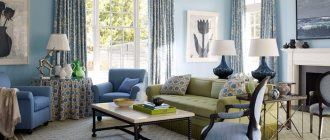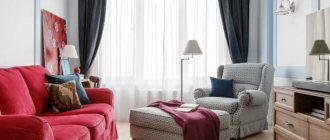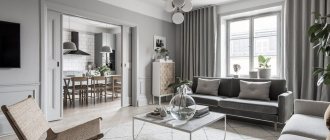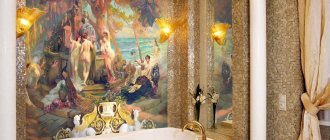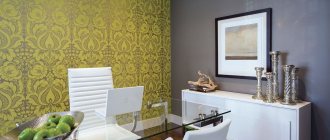The main purpose of the living room is to receive visitors, a place for organizing festive feasts and parties, as well as a relaxing holiday for the whole family. It is not surprising that the owners approach the design of this premises with all responsibility. The interior must meet a number of strict requirements:
- to be comfortable, homely;
- have your own, unique appearance, reflecting the habits, lifestyle and worldview of the owners;
- embody the latest fashion trends or, on the contrary, create a feeling of reliability and respectability;
- create a certain mood that ideally suits the character of the residents;
- make a favorable impression on guests, delight the owners with their beautiful appearance.
If necessary, living rooms are divided into functional areas or combined with a kitchen. In this case, each section is worked out separately, with its own flavor, but the general style is necessarily preserved, uniting all sections into a single whole. One of the most beloved, sought-after colors in which state rooms are decorated is blue. The azure palette provides enormous scope for bringing unusual, magnificent designs to life. It is multifaceted and incredibly attractive, giving a feeling of flight and spaciousness. We will tell you how to decorate a living room in blue tones and choose furniture, what ideas to use, and show examples in this article.
Designers and psychologists about the features of blue living rooms
From the point of view of experts, the interior of a living room in blue colors is always filled with tranquility. Everything in it seems pristinely clean, and the atmosphere is full of serenity. This is explained by the special naturalness of the color, associated with the sky, air, clear water and eyes. In general, this spectrum evokes only positive emotions and creates a positive mood, and blue brings with it the listed qualities to any room, and not just to the living room. This is the answer to the secret why psychologists advise that one of the rooms of the house be decorated in a blue palette.
blue living room design
The combination of colors of furniture, walls, ceiling and floor in the bedroom interior
The bedroom is intended for relaxation and privacy of a person. The elements and colors of the final interior should create a pleasant, calm and cozy atmosphere.
Choosing paints for the bedroom is quite simple, since there is a simple table specifically for this living space.
The main color of the room is selected based on the concept chosen by the designer. Most often, bedrooms are made in a beige shade, with the addition of dark wood elements.
This combination will create an atmosphere of comfort and privacy, which is what they most often try to achieve when creating the interior in these rooms.
The walls of the room must be made in calm, preferably coffee tones. The floor is made of dark wood, which will go well with wooden inserts in furniture of the same color.
If we talk about a bedroom in bright colors, in this case there is even more variety. Most bright shades match each other both in furniture and decorative elements.
Blue living room: color sketches
“Wanting to create a bright and dynamic blue living room interior, you need to turn to the blue, orange and pink spectrum”
The blue spectrum is full of tint variations, which allows the living room interior to appear before the eyes of guests not only in the common color of sea wave or pompous palace blue, but also in more sophisticated forms.
Modern living room decor is:
- Azure.
- Aquamarine.
- Sky blue, almost dissolved in the whiteness of the clouds.
rich blue color of the walls in the living room interior
Like any other interior colors, blue has a number of partners, whose presence will never spoil the overall impression of the decor. For example, if you want to create a bright and dynamic interior for a blue living room, you need to turn to the blue, orange and pink spectrum. These colors will create a “warm” counterbalance to the main blue background. The presence of purple, pistachio, light violet and turquoise will perfectly “invigorate” the atmosphere.
If you combine blue with brown, terracotta, whale-blue shades, we get a real classic of the interior genre. To add a little warmth to such a living room, you need to slightly dilute the palette with the brightness of yellow, which can easily be introduced with the help of accessories.
blue furniture against the background of beige walls in the living room interior
The interior of the living room, in which blue is combined with pastel sandy yellow, light pistachio tones, light khaki and brighter orange, will envelop you in a very calm, balanced and gentle atmosphere.
When implementing the design of your living room, be sure to follow two basic decor rules:
- Determine where the room's windows face.
- Combine tones correctly.
variations of different shades in the interior from blue to soft blue
If the room does not lack sunlight, then its interior should contain cooler colors, but in poorly lit rooms that are not initially pleasant with warmth, the advantage should remain with the warm spectrum.
As for color combinations, there is no need to reinvent the wheel here either. Combine cool shades with cold ones, and a warm palette with warm ones. These tips will help you create an original blue living room, even for those who are new to design.
dark blue wall color in living room design
Furnishings
With the help of comfortable furniture, a place for sleeping or daytime rest, work, or practicing your favorite hobby is organized. The guest area is set up on a sofa, next to a table, usually opposite the TV. If the room is combined with a loggia or an insulated balcony, guests are also received there. When the hall is combined with a kitchen, it is separated using a bar counter or a narrow shelving unit.
When the walls are pale blue, the furniture is made brown, white, yellow and vice versa. But it is not recommended to design the entire set in light blue tones. A huge sofa upholstered in bluish leatherette, the same armchairs, and window drapes look good. The rest of the furniture - a wall cabinet, dining and work tables, chairs - is yellow-brown, any wood shade. Partially or completely glass furniture will give the room an airiness, which is most important in small rooms; shiny metal surfaces that reflect light well will also come in handy.
Techniques for decorating surfaces in blue paints
«It is better to leave the ceiling of the blue living room in a classic white solution.”
When you decide to decorate the living room walls with blue wallpaper, try to find something light. This will become a universal option. In a dark room, other shades of this spectrum may look simply “dirty”, making the interior seem uncomfortable and gloomy. Playing under the rays of the sun, blue will delight you with its beauty and lift your spirits. A good solution for the living room would be an accent wall. You can hang a TV on it or arrange a fireplace against its background.
A popular solution remains painting the living room walls with blue and white stripes. This refreshes the atmosphere and makes the interior more attractive, but do not forget that this technique only works if you choose faded blue colors. Bright blue stripes will hurt the eye and will clearly not cause admiration.
aquamarine in the living room interior
It is better to leave the ceiling of the blue living room in a classic white solution. This will highlight the background of the walls and make the room visually more spacious. For floors, ideally choose a covering in the form of parquet or laminate in the color of natural wood. Sometimes they stop at white ceramic tiles.
Psychological perception, color features
This color is associated with innocence and dreaminess, altruism and loyalty, spirituality and aristocracy. It has a calming, relaxing effect on a person, encourages rest, slows down a rapid pulse, and relieves excessive excitement after a hard day at work. In the interior, blue colors create the impression of cleanliness, coolness, and freshness. Therefore, it is preferable to use its bright shades in spacious rooms, with large windows facing the south or southeast. In tighter rooms, with small northern or northwestern windows, blue is allowed, but only its lightest versions in combination with various warm colors are acceptable.
There should not be an excess of blue in the interior - then it can cause melancholy and a depressive mood.
Furnishing the living room in blue
A room decorated in light colors should be furnished with upholstered furniture with blue or turquoise upholstery. If the main background is more saturated and deep, then sofas and armchairs in muted shades are placed in the room. Gray and white furniture will fit perfectly into the decor of such a living room. Bright accents on neutral furnishings will be sofa cushions, which are selected in accordance with the general concept in white or sand covers. Many people consider white furniture completely impractical and try to avoid it. And completely in vain! Today it is quite possible to compensate for this shortcoming with properly selected finishing materials. This could be, for example, leather that is easy to care for.
blue furniture in a classic living room with fireplace
Popular stylistic color trends
There are many design directions for a blue interior:
- classic or neoclassical - natural materials (wood, natural stone, ceramics), symmetrical arrangement of furniture, contrasting with a blue background. In the neoclassical style, functional furniture is selected, designed “classically”;
- loft - a spacious space with an open plan, plastered or brick walls, antique furniture. The blue color here will emphasize the coldness and seeming uninhabitedness of the room;
- hi-tech - an abundance of gray and bluish metal, glass surfaces, emphatically modern furnishings, which is most noticeable if the living room is combined with a kitchen. A huge TV in the center of the wall will complete the interior;
- Japanese is modest and minimalistic. The decoration is the simplest, there is a reed mat on the light blue floor, a tall narrow aquarium with strange fish, a decorative fountain, and elegant floor vases are acceptable as decoration;
- Baroque - “rich” carved furniture, upholstered in expensive fabrics, luxurious and abundant decor. Stained glass windows in shades of blue, heavy curtains, numerous framed paintings, candles in gilded candelabra or their imitation are welcome;
- marine - everything that is in any way connected with the sea is acceptable here. Photo wallpapers depicting seascapes or the underwater world, a sofa stylized as a steamship, a papier-mâché sailboat on a shelf would be suitable;
- Provence - blue is combined mainly with white and pale yellow. A fireplace, curtains with small flowers, paintings or photographs depicting lavender fields, bouquets of cornflowers or bells will fit perfectly into the decor;
- minimalism - suspended ceiling, painted walls are made of the same shade, the floor is darker. A few pieces of furniture merge with the walls or contrast with them;
- Empire - all the walls are pale blue, the floors and doors are dark, the furniture is arranged mainly diagonally. The decor of the room is very luxurious, elegant, noble. There is a lot of stucco with gilding on the ceiling and walls.
Evening living room lighting
The interior of a blue living room in the evening requires special lighting .
Since blue itself is the direct personification of cold, you should not enhance this effect with the same lifeless glow of night lamps. Lighting in combination with main lighting lamps will help not to disturb and sufficiently illuminate the color beauty of the room. The latter can be ensured by a powerful ceiling chandelier with lamps emitting warm spectrum light. There are no special frills for spot illumination. It can be standardly built into the ceiling along the perimeter of the walls. In this case, the lamps will illuminate background surfaces well. Instead of halogens, you can use blue LED strips and blocks.
crystal chandelier with candlesticks in a living room decorated in blue
In contrast
Green walls - pink ceiling? Why not. Since the colors are complementary to each other, such a duet will look fresh and harmonious. Just choose muted shades in a matte finish, such as from the Little Greene palette.
Ceiling color - Blush No. 267, walls painted in Sir Lutyens' Sage No. 302 and Invisible Green No. 56, Little Greene
Textiles and other decorative elements
A blue living room will acquire special elegance if its windows are decorated with turquoise curtains of a simple, strict cut .
The fabric for curtains should have a dense texture and stand out against the background of the surrounding walls. An alternative to turquoise can be chocolate, gold and brown curtains. As an option, Japanese two-color curtains, as well as classic fabrics decorated with large patterns, can be considered. When choosing accessories, you should look at the style of the interior. A nautical living room might feature a vase filled with sea shells or stones. On the wall in this decor a ship’s wheel or a marina with a sailboat would be appropriate. The easiest way to emphasize a rustic style is with tall floor vases and figurines.
blue curtains in living room interior design
Conclusion
When designing a design, you need to try to calculate everything so that the blue living room does not look like a lifeless icy desert.
Of course, at first, a light and bright interior will completely suit you with its freshness, but very soon the coldness of the tones will openly irritate, tire you and deprive you of the desire to work. These aspects are the prerogative of all cool colors, so do not leave the living room in a purely blue solution, dilute its decor with bright warm accents and remember that there can be up to 20% of them in such an interior, so do not try to limit your impulses too much.
duet of blue and green in the living room interior
A little taste and imagination will turn your living room into a truly luxurious room for entertaining guests, which you can deservedly be proud of!
Painting the ceiling
Having figured out which paint is best to paint the ceiling, now let’s look at how to perform this operation correctly. You should start by preparing the room. To do this, first of all, you need to prepare the room - remove all the furniture, cover the floor and other surfaces that need to be protected from paint contamination.
In the photo - a paint roller with a tray
Tools
After cleaning the room, you need to prepare a tool for applying paint.
For these purposes you can use:
Most often, the work is done with a roller, and hard-to-reach places are tinted with a brush. In this case, you will also need a pallet or other container for paint.
Preparing the base
Before painting the ceiling in a room, it is necessary to prepare the base.
The work is carried out as follows:
- Preparing the base begins with removing the old coating. This procedure is performed differently, depending on the type of old coating; for example, whitewash and water-based paint are simply washed off with water. Waterproof paint will have to be removed mechanically - with a spatula or a grinding machine with a special attachment.
- Then, the ceiling must be treated with a primer, which will improve adhesion between the materials, have an antiseptic effect on the ceiling, and also strengthen the base, for example, old plaster. The primer is applied to the surface using a roller in an even thin layer. Typically, this operation is performed in two steps.
- After the primer has dried, the surface must be puttied to remove all cracks and other defects that may have appeared during the process of removing the old finish. The putty is applied in an even thin layer using a wide spatula. As a rule, two layers of material are applied to the ceiling - starting putty and finishing putty.
After the finishing layer has dried, it must be sanded with fine sandpaper to obtain an ideal surface.
The final stage of preparing the base is applying another layer of primer. This procedure is necessary, as it will reduce paint consumption and ensure uniform absorption.
Advice! If the surface of the ceiling has large differences, then it is more advisable to cover it with plasterboard and then putty.
Scheme for applying paint to the ceiling
After performing all the above-described manipulations, you will get an absolutely flat and smooth surface, prepared for painting. We can say that the most difficult part of the work has been completed. Now you need to figure out how to paint the ceiling correctly.
So, this is done as follows:
First of all, you need to prepare the paint. As a rule, water-dispersible compositions are sold in white. If you want to give the ceiling any shade, then you need to add the appropriate color to the paint.
This can be done either directly in the store, using a special device (if available) or with your own hands. In the second case, you need to first mix a small amount of paint with the color to find out the proportions to obtain the desired color. After this, the color is added to the main part of the composition and thoroughly mixed with a mixer or electric drill with an attachment.
- Then the material must be poured into a special tray for the paint roller.
- Before application, the tool should be dipped in paint and squeezed on a special platform to avoid drips and splashing.
- As a rule, novice craftsmen are interested in where to start painting the ceiling? Experts recommend starting painting from the corner opposite the window, as shown in the diagram. The paint should be applied in a thin, even layer, so don’t try to paint the surface perfectly the first time.
- After the first layer of coating has dried, the paint is applied again. The direction of painting should be perpendicular to the first layer.
- Then hard-to-reach places can be touched up with a brush.
Advice! Many people are interested in whether it is possible to paint stretch ceilings? The answer depends on the type of ceiling itself. It is allowed to paint only seamless fabric material, exclusively with acrylic paints.
Now that the painting is complete, you can now begin finishing the remaining surfaces of the room.
As we found out, painting the ceiling is really a fairly simple procedure that is accessible to everyone
The only thing is that you need to pay special attention to preparing the base, and also follow a certain sequence of work, which is given above
Without this, you will not be able to get a high-quality result. For more information on this topic, watch the video in this article.
